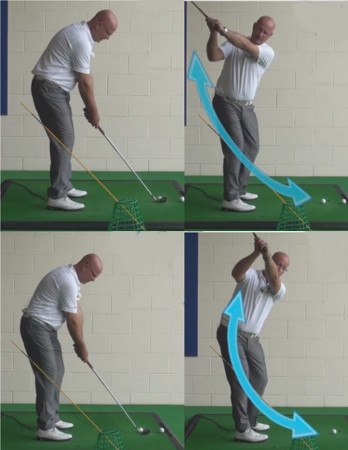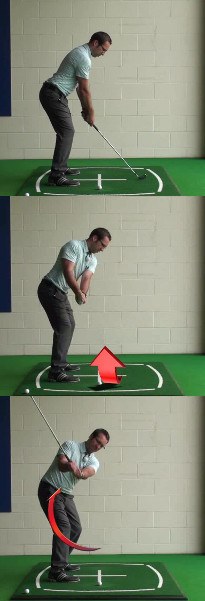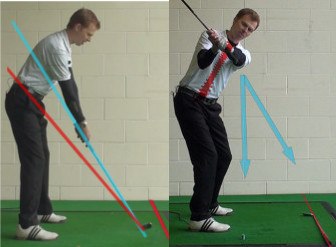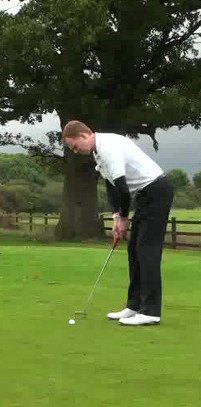Swing plane is important in golf.

The plane of your swing refers to the path that the shaft of the club takes during the backswing and downswing. By using the right plane to match up with the rest of the mechanics in your swing, you can set yourself up for solid ball striking shot after shot. On the other hand, if your swing plane is off track, you’ll struggle to reach your potential. In this article, we are going to discuss how you can manipulate your swing plane by adjusting how far you stand from the golf ball at address.
We understand that thinking about how far you are standing from the ball is probably not the most exciting part of playing golf. You’d probably prefer to be out on the course playing the game than standing on the range working on this boring piece of your technique. However, if you are serious about improving your game moving forward, you’ll be willing to invest some time in these kinds of basics. It is the simple building blocks of your golf swing that can make or break your results in the end. Without putting a quality foundation in place, it will be nearly impossible to build a golf swing that stands the test of time.
This article is going to cover the topic of swing plane in a variety of ways. First, we are going to talk about how your swing plane impacts the golf shots you are able to hit. There isn’t necessarily one ‘right’ swing plane to use, but there are pros and cons to different planes, so understanding this topic and how it impacts your ball flights is important. With that out of the way, we’ll move on to discussing the relationship between the location of your feet and the swing plane that results. By the end of the article, we hope you have a firm grasp of this topic, and we hope you feel ready to get out on the range and work on this element of your game.
All of the content below is based on a right-handed golfer. If you happen to play left-handed, please take a moment to reverse the directions as necessary.
Why Does Swing Plane Matter?

The topic of swing plane can be a little bit confusing for some golfers, especially those without very much experience in the game. In this section, we’ll do our best to make this topic clear, and we will talk a bit about why it is important. Golf is a complicated game, and every bit of additional knowledge you can acquire should be seen as a step closer to reaching your goals.
First, let’s talk about what swing plane is not. Swing plane is not the same thing as swing path, although the two do seem pretty similar at first. Basically, your swing path is the path traced by the club head as it moves down through the hitting area. So, if your club head travels directly down the intended target line toward the target, you are said to be swinging perfectly ‘down the line’. While that sounds like the easiest way to go, a swing that actually heads directly down the line would be pretty rare. More often, players either swing from inside-out or from outside-in. The former is great for producing a draw, while the latter is what you will tend to see from players who hit a fade. Without question, the concept of swing path is one of the most important in the game of golf.
But it is not what we are talking about here. Rather, we are talking about swing plane, which is a different discussion. The best way to understand the difference is to focus on the shaft of the club rather than the club head. As the club swings around you, both back and through, the shaft traces a plane. It’s hard to see this plane when watching a swing live, because the swing happens so quickly, but it is there. To visualize the swing plane of another golfer, pay attention to their address position. If you are standing behind them as they swing (standing a safe distance back, of course), you can see the plane of the shaft that is established at address. Once the club goes in motion, the plane will become dynamic as the club swings up to the top and then back down again. Golf teachers often use swing plane to help their students improve, and they will frequently draw lines over top of video recordings of the player’s swing in order to help them understand the concept.
Okay – hopefully we haven’t lost you just yet. The starting plane of the swing is established at address, but that doesn’t mean that the plane is destined to stay the same once the club goes in motion. In the golf instruction world, there are two categories of swings often discussed – one-plane swings, and two-plane swings. As the names would indicate, a one-plane swing is one where the player attempts to maintain the same plane throughout the swing from start to finish. On the other hand, a two-plane swing has the golf switch planes during the swinging action, usually at the top as the club begins to move into the downswing. Neither one of these is right or wrong, as players have succeeded with both options, even at the highest levels of golf.
Let’s go back over what we’ve said above just to present it in another way. The swing plane is the path that the shaft of the club takes during the action of hitting a shot. Your initial plane is established at address when you set the head of the club down behind the ball. Then, once the swing begins, you can either attempt to maintain the same swing plane for the entire swinging action, or you can use a two-plane swing and shift planes at the top. This is a hard thing to explain clearly, but we hope it makes sense.
So, with that out of the way, why does any of this matter? The points below will address the importance of swing plane.
- Encourage the desired ball flight. We are going to talk more about this later in the article, but your swing plane has a lot to do with the type of ball flight you will produce. Generally speaking, those who use a flatter swing plane will tend to hit a draw, while those with a more upright plane will tend toward a fade. Those are certainly not hard and fast rules, as its possible to turn the ball in the opposite direction of those patterns, but they do hold true most of the time. So, if you would like to play a draw, it helps to know that you probably want to employ a relatively flat swing plane.
- Repeat your shots. Would you like to strike the ball more consistently? Of course you would – all golfers would love to improve on their consistency. By knowing what type of swing plane you are trying to use, and by repeating that plane over and over again, you can become a more consistent player. If your swing plane is changing from swing to swing, it will be nearly impossible to produce the kinds of reliable results that consistent golfers require.
- Give yourself a purpose. You can think of your swing plane as a roadmap to your golf swing. When you know what kind of swing plane you are trying to use, you can focus on following that plane from address up to the top of the swing, and back down toward impact. For a single-plane golfer, that means tracing a repeating path back and through. For the two-plane golfer, there will be a shift involved at the top, but there is still a clear purpose to the swing. If you frequently feel like you are a little bit lost when standing over the ball getting ready to hit a shot, focusing on your swing plane could give your game some much-needed direction.
We have included a lot of content in this section, and we hope that you have been able to keep it straight. There is no doubt that the topic of swing plane can be a bit confusing for many players, but keep thinking about it and reading about it until you grasp the concept and its importance. In the long run, you should be able to make better decisions about the direction of your game, and you should be able to make more progress with your swing, thanks to your understanding of swing plane.
Where Should You Stand?

At this point, we are going to get back to the topic raised in the title of this article – the connection between where you stand at address and the swing plane you use to hit your shots. While much of the discussion on swing plane can be a little overwhelming for a beginning golfer, the concept here is actually quite simple. If you move your feet farther away from the ball at address, it is likely that your swing will become flatter. On the other hand, if you stand closer, you’ll probably make a more upright swing. That’s really all there is to it.
It comes down to the angle that the shaft forms with the ground when you set up for your shots. As you back up, the shaft is naturally going to have to lay down in a flatter position. That means you are immediately set up for a flatter overall swing shape. If you were to move in closer to the ball, you would have to stand the club up in a steeper position just to form a reasonable stance. If you trace the plane that the shaft has formed at address and continue it through the swing, you will wind up with a relatively steep swing plane.
Unfortunately, there is no perfect place to stand when getting ready to hit a golf shot, as all players are different. Some golfers like the feeling of making an upright swing while standing close to the ball, while others prefer to have more room and like to swing in on a flat plane. You can go either way and have success, so you’ll have to work out which one is right for you (more on that later). What can be said here, however, is that you need to make sure to match the positioning of your stance with the kinds of shots you are trying to hit. If you are trying to play a fade most of the time, standing well back from the ball is a bad idea. You are going to have a flat swing and the ball is probably going to want to draw. The opposite holds true as well, as trying to play a draw while standing up close to the ball is going to make things difficult. Make sure your stance makes sense for the type of game you are trying to build.
Test It Out

The driving range can be thought of the testing ground for your golf game. You don’t want to test out new techniques or ideas on the course, because you are trying to perform your best while playing a round of golf. On the range, however, you have a bucket full of balls and no reason not to experiment a little bit. When it comes to figuring out how far you should stand from the ball, the driving range is the perfect place to test out various address positions until you find one that works nicely.
The key to conducting a successful test on this point is to be precise. The following step-by-step process will explain how you can experiment with the connection between your stance and your swing plane.
- Start by picking a single club from your bag to use for this process. You can wind up using a variety of different clubs, of course, but it is a good idea to start with just a single club. You are free to use whichever full swing club you would like, but we recommend you use a seven iron. The seven iron is long enough to see the impact that your swing plane will have on your ball flight, but short enough to be relatively easy to hit.
- With your seven iron in hand and a number of golf balls waiting nearby, you are ready to hit your first shot. This first shot should be played with your feet in their usual position. Before you hit the shot, however, reach down and lay another golf club on the ground just in front of your toes. This extra club should be parallel to your target line and just in front of your toes far enough to avoid getting in the way during the swing. By laying the club on the ground, you will have a point of reference to know where you were standing on the first shot.
- After you’ve hit the first shot, set another ball up in the same position at the first ball. For this shot, however, you are going to move your feet back just slightly from that extra club you laid on the ground previously. Don’t move back dramatically at first – just an inch or two will be enough to notice a difference. With your feet in this new position, hit a handful of shots and pay attention to the results. How do these swings feel? What has happened to your ball flight? It might take a few swings to get comfortable, so don’t overreact if the first couple shots are pretty ugly.
- You can continue on with this process, moving farther back (or closer, if necessary) as you go. The key is to mark the position of your stance so you can be sure you are actually moving closer or farther away on subsequent swings. It may take a while, but you should eventually find a position that feels good and leads to quality results.
It is one thing to read golf instruction in a book or online. It is another thing entirely to actually get out and experiment for yourself. Most likely, the concept of swing plane and what it means in your game will start to make a lot more sense once you begin experimenting on the driving range. You will be able to feel how the changes are impacting your performance, and you will be able to decide what type of swing plane leads to the best results in your game.
What Are the Short Game Concerns?

Believe it or not, the importance of swing plane is not restricted to the long game. This concept actually plays a role in your short game as well, and we are going to talk about the short game here in the last section of this article. Just like when hitting a full shot, the distance that you stand from the ball is going to directly impact the swing plane you use when putting or chipping.
When talking about swing plane in the short game, we aren’t going to be concerned with ball flight, because the ball isn’t going to be in the air long enough to turn right or left. Instead, what we are concerned with here is the way you strike the ball at the moment of impact. When you set the club on a good plane for a short game shot, you should be able to arrive at impact with the sole of the club flush on the turf. In other words, the toe of the club won’t be up in the air, and neither will the heel. Instead, the sole will be flat on the ground, and you’ll have a good chance to hit your target. This is just as important when putting as it is when chipping.
To put your club in the right spot, the best thing you can do is build your stance in the right order. Many golfers set their feet in position before putting the club down behind the ball, but that is the wrong way to go about it. Instead, you should be placing the club head behind the ball first and then setting your feet. This might seem like a subtle difference, but it is extremely important. If you set your feet first, you will be forced to manipulate the club into a position that might not be quite right for hitting the shot you have in mind. By setting the club head down and then building from that point, you can make sure the club is in the perfect position – and that’s the most important piece of the puzzle.
The reason that you need to be concerned with swing plane in the short game is because of the loft that is on each of your clubs (yes, even your putter has loft). For example, when the toe of the club is up in the air, the loft of the club will cause the face to actually be aimed left of where you are looking. Likewise, if the heel of the club is in the air, the club will be aimed to the right of where you are trying to hit the shot. Setting the club flat on the ground and then swinging along that plane will take these complicating factors out of the equation.
Swing plane is important. We hope you now have a basic understanding of this topic, and we hope you have the motivation necessary to head out to your local driving range to work on this part of your game. With any luck, you’ll be able to find the right distance to stand from the ball so you can produce a consistent, reliable swing time after time. Swinging on a good plane might not fix everything that ails your golf game, but it is a good start. Good luck!






